How to grow winter brassicas: expert tips for cabbage, cauliflower, kale, sprouts and sprouting
Follow our guide on how to grow winter brassicas and these hardy veg are guaranteed to get you through the cooler months
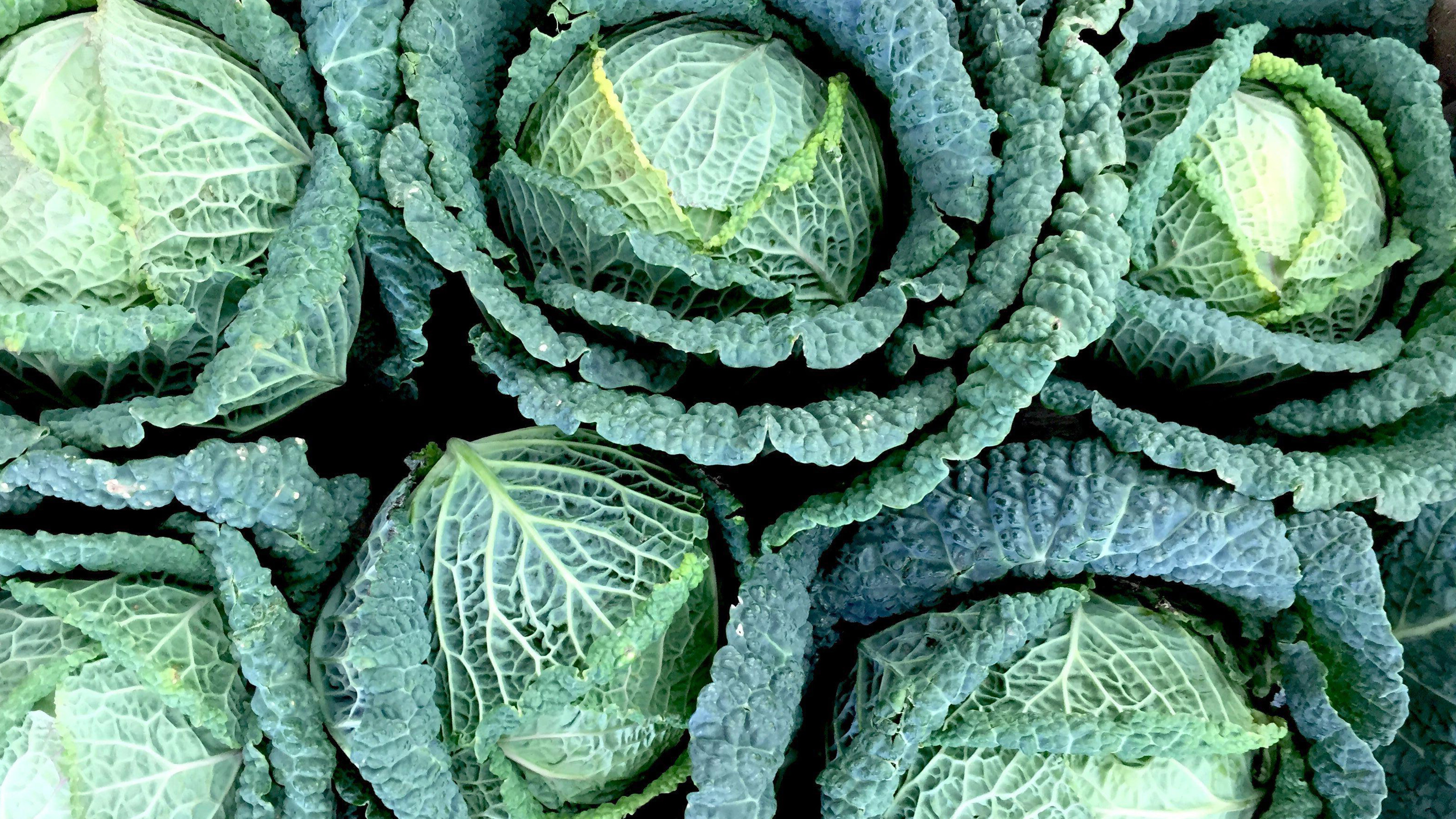

A few moments spent learning how to grow winter brassicas will be time well spent. We know it’s sometimes hard to think months ahead, especially when you’re starting to reap the fruits (and veggies) of your hard-earned labors. But follow our guide to growing these kitchen stalwarts, and you’ll thank us later.
Perfectly attuned to cooler temperatures, and designed to reach their peak during leaner months, winter brassicas cover a lot of bases and work hard for their spot in your garden – and all for very little effort. Whether your tastes run to chunky cauliflowers, purple sprouting or flamboyant crispy Savoy, there’s something here to please every palate. And they’re all simple to start off.
Call these crops your quintessential classics: they never disappoint. Winter cabbage and cauliflower, sprouts, sprouting and kale are all part of the Brassica oleracea group of winter vegetables. These nutritious culinary reliables come into their own when the rest of your kitchen garden is slowing down or turning up its toes. All they need is space to grow, plenty of moisture, and a hearty, fertile base in beds or deep pots.
Here we’ll show you the simple sowing, planting and harvesting secrets for how to grow winter brassicas so you can have an abundance of lush, leafy crops in the cool months to come. Plus, you find out how to grow another kitchen favorite with our guide on how to grow garlic.
Which winter brassica should I try?
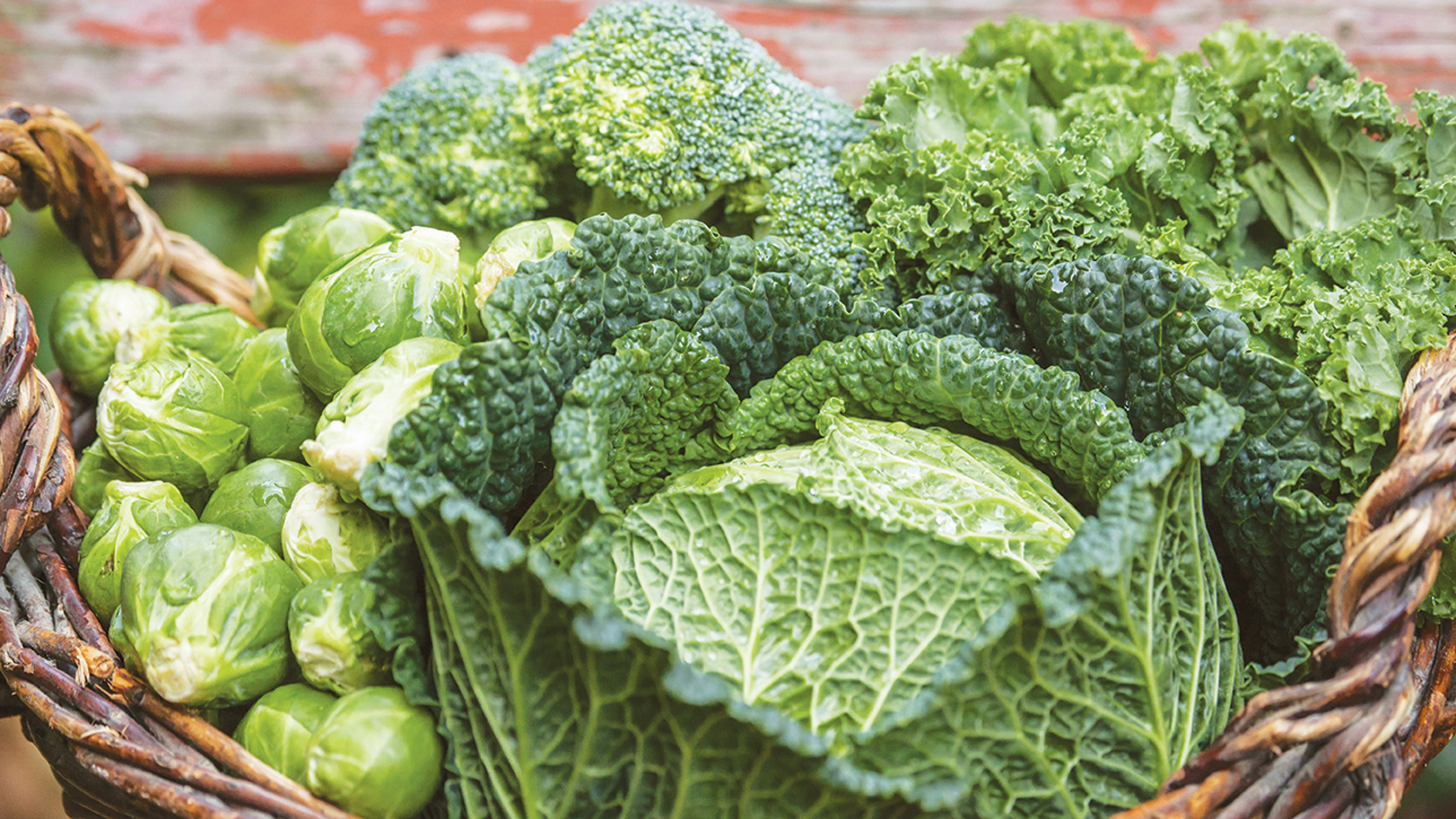
If you fancy finding out how to grow winter brassicas, the first surprise is how vast this group is. Together, these hardy veggies provide the main thrust of a cool season harvest, packing a mighty punch in both flavor and nutrients. But as a group of unique crops, there are some striking contrasts, too.
In terms of basic appearance, cabbages and cauliflowers have relatively short, squat stems. The cabbage ‘head’ is formed by leaves broadening and curving inwards to form a tight heart. A cauliflower curd is made up of thousands of buds on this short stem. By comparison, Brussels sprouts and purple sprouting have elongated stems. Sprout buttons are enlarged leaf buds, while those of sprouting develop into long flowering side-shoots.
That said, there is a lot of overlap in the cultivation and care of these veggies. We’ll outline the basics of sowing, planting and caring for them all. We will also point out where a particular crop requires further care.
1. Winter cabbages
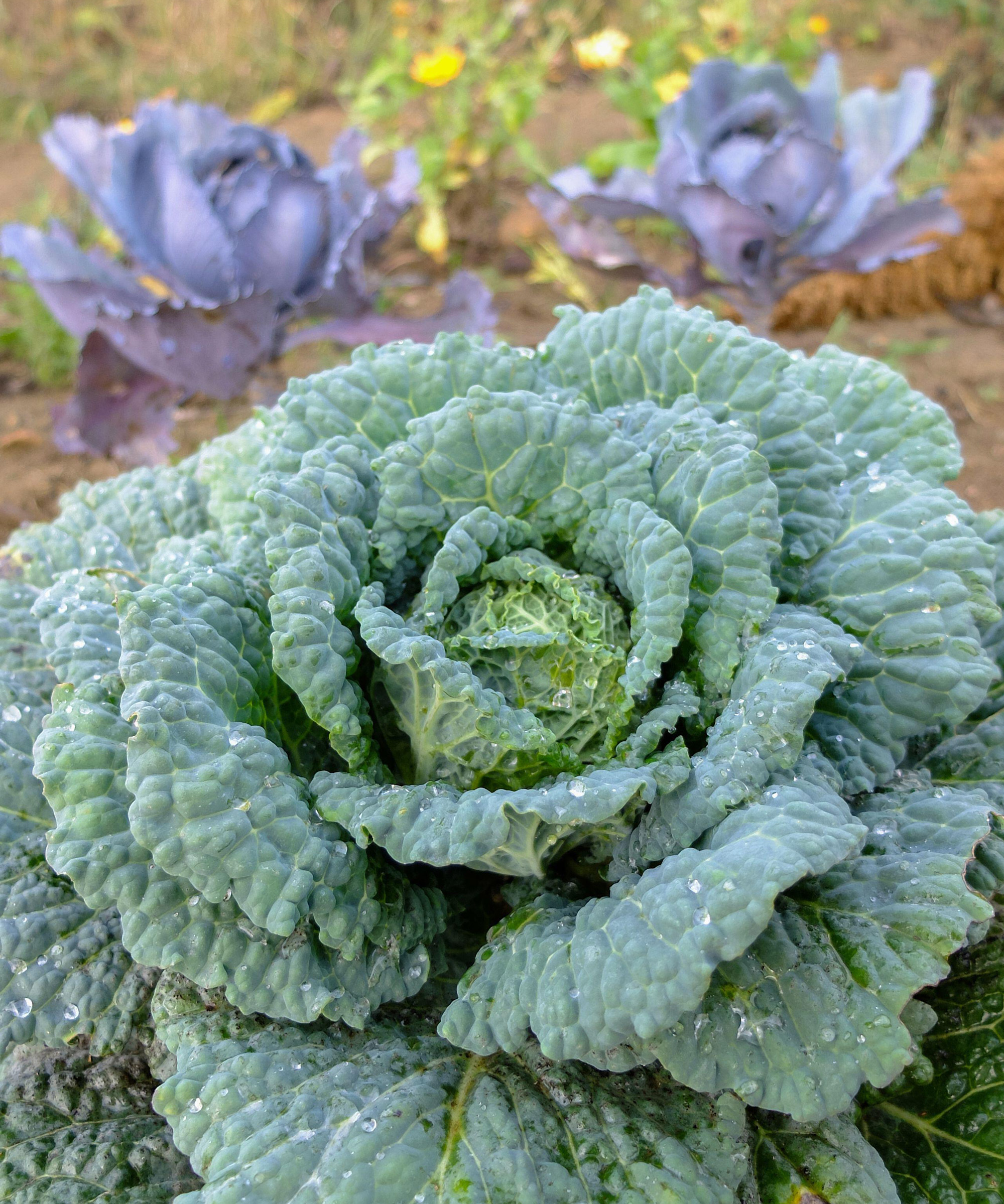
Cabbage is a crucial leafy green to have around in winter, but that does not mean they are just green. Some winter cabbages (such as ‘Marabel’) have lively red and purple hues. Open or pointed, they vary in hardiness, from squeaky, leathery leaved Danish ball-heads to thinner, crinkle-cut Savoy varieties.
Lovely for winter soups, but also amazing eaten raw in coleslaw. Try ‘January King 3’, ‘Wintessa’, (Savoy) ‘Tundra’, ‘Marabel’, and ‘Celtic’.
See our guide on how to grow cabbage for more details.
2. Winter cauliflowers

It might have a reputation amongst gardeners for being tricky to grow, but if you plan properly, winter cauliflowers can be some of the most rewarding crops you ever try. The lure of clusters of creamy white curds is a surefire winter warmer. However, there’s also vibrant new breeds in yellow, green and purple to tease the palate – they look amazing in flowerbed ideas and borders too. Try: ‘Romanesco’, ‘Moby Dick’, ‘Patriot’, ‘Triomphant’.
You can also find out how to grow cauliflowers with our guide.
3. Kale

Superfood par excellence, kale (or borecole) is essentially a wild cabbage and a great one to try if you're considering how to grow winter brassicas. With its elegantly draping leaves held aloft on mighty stalks, the mature plants look like giant candelabras.
Frilly ‘curly leaf’ varieties are highly attractive and are great for large container gardening ideas as well as dotting around the plot. Despite their reputation for bitterness, new breeds are also remarkably sweet, delightfully low-maintenance and hardy. Try ‘Dwarf Green Curled’, ‘Scarlet’, ‘Redbor’, ‘Nero di Toscana’ (Black Tuscany), ‘Winterbor’.
See our guide on how to grow kale for expert growing tips.
4. Brussels sprouts

While forever linked to (possibly ill-fated) Christmas dinners, Brussels sprouts are surprisingly versatile – as well as high in vitamin C.
Choose your varieties well and you can pick these nutty button beauties well into February. New breeds include short stem varieties that are less prone to toppling on the plot. Try: ‘Nelson’, ‘Bosworth’, ‘Falstaff’, ‘Trafalgar’, ‘Wellington’.
Check out more tips on how to grow Brussels sprouts with our guide.
5. Purple sprouting broccoli
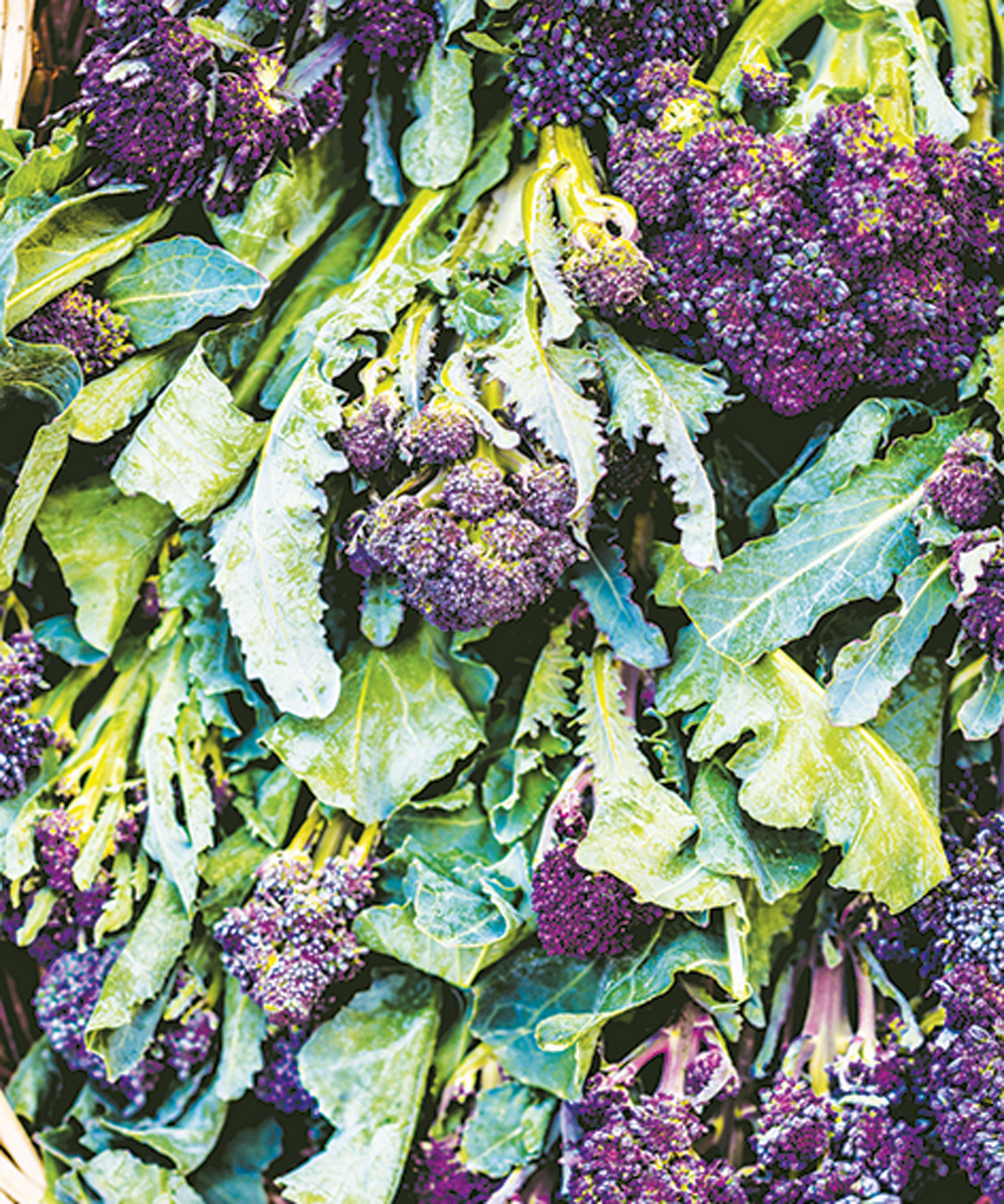
Another good option for anyone learning how to grow winter brassicas, this brassica (usually purple, although it can also be white) is a cut-and-come-again crop with a long harvesting season.
Thanks to its massive vitamin content and high levels of folic acid, its crops of colorful clusters are highly nutritious. There are early and late varieties available.
Try ‘Early Sprouting Rudolph’, ‘Red Arrow’, ‘Late Purple Sprouting’, ‘White Star’, ‘Claret’.
6. Kalettes

This curious cross-breed winter brassica from Tozer Seeds is pitched somewhere between kale and sprouts. Its delicately bundled, open leafy parcels come in a mix of reds and greens, and they have a mild nutty taste. The plants can reach 2ft (60cm) tall and, like sprouts, will benefit from staking.
Try 'Autumn Star', ‘Mistletoe', ‘SnowDrop’, or a mixture of all three to extend the cropping season.
When to grow winter brassicas

One of the main things to remember about how to grow winter brassicas is that they are quick to mature. You need to factor in ample time to see these plants through to winter harvests. Follow the seed instructions for your variety.
As a general rule, when mastering how to grow winter brassicas, sow between April and June, then plant out in June-July. While your cool croppers are quietly developing, you can then distract yourself with summer harvests of peas and beans, tomatoes and courgettes! To find out more about how to grow courgettes, read our guide.
Just remember, winter brassicas like to start off in warm soils and grow in cool weather: use this as the basis for your sowing and growing. Stick to the April-June months for starting off. You can start some varieties sooner, as long as you keep sowing conditions warm (under glass). All is not lost if you think you’ve left it too late to sow: you could still plant out plugs from reliable suppliers.
- Winter cabbages: Sow in April-May, transplant June-July.
- Winter cauliflowers: Sow seed in May, plant out late June-July.
- Sprouts: Sow early March-May, transplant mid-May to early June.
- Kale: Sow March-June, plant out late May-June.
- Sprouting: Sow in March for harvests in winter, or sow in April-May to transplant June-July, for harvests Jan-March. (You can sow as late as June for some later varieties.)
It’s worth growing both early and late varieties. This gives you a longer cropping period for your brassicas. It’s also a sensible insurance policy in case one variety fails to germinate or mature for whatever reason.
Want to start off some leafy crops over winter? Our guide on growing lettuce in winter shows you how to get started with winter salads.
How to grow winter brassicas
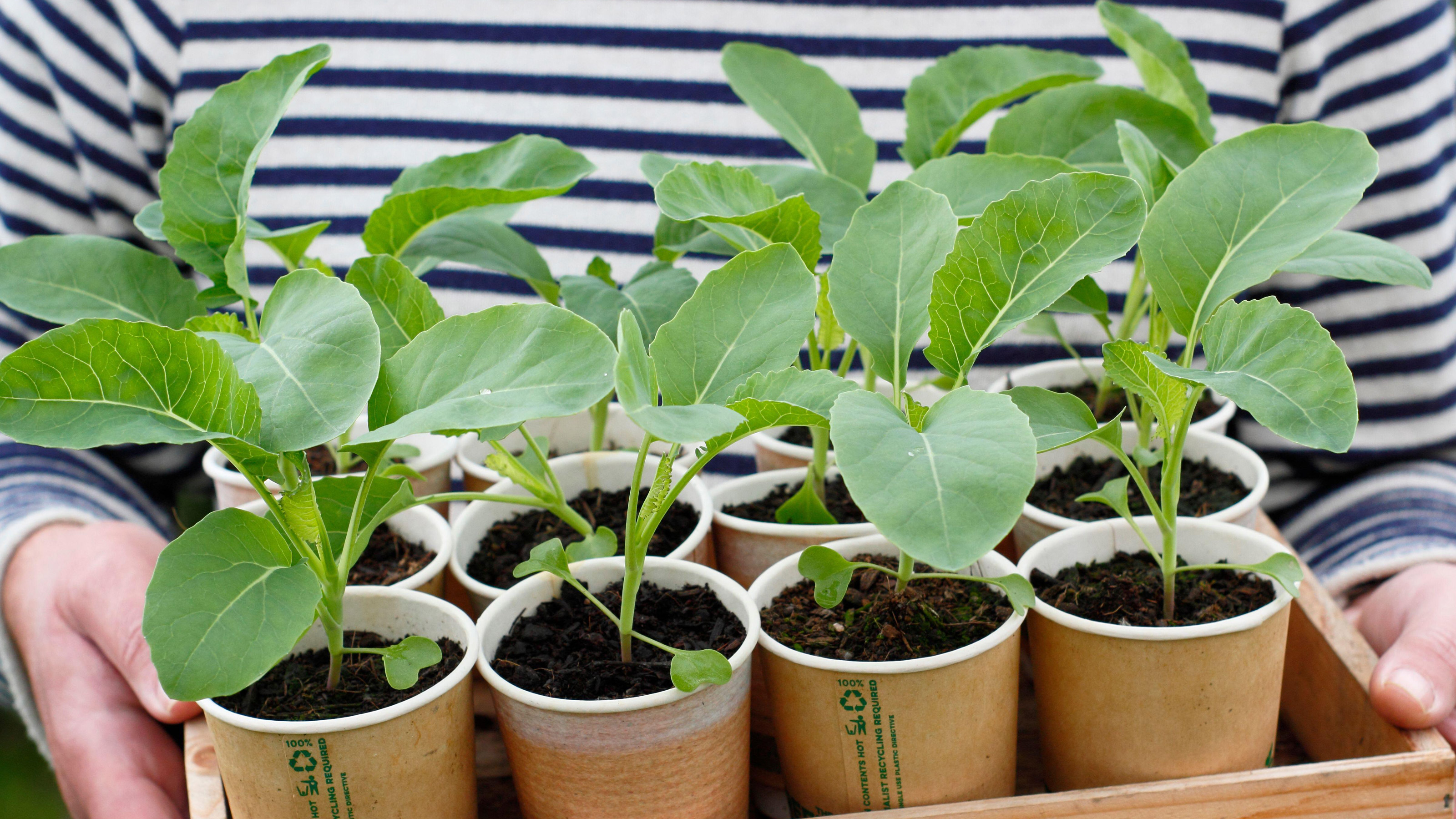
Despite the fact that we’re considering a diverse group of veggies with unique characteristics, learning how to grow winter brassicas is quite easy – honest! Before you start, just give some thought to the soil and prep accordingly.
- Soil conditions are important, as brassicas need firm planting. They like to be secure, especially those taller majestic kale and sprout varieties. Loose soil can make the plants wobble, tilt, or worse. If you dig before planting, make sure the ground isn’t too ‘fluffy’. It may help to firm lightly with your foot before you plant.
- These plants develop extensive root systems, and moisture supply is key to big yields. Soil fertility is also important, especially for cabbages and cauliflowers. Add some garden compost or well-rotted manure to the soil to ease compaction and boost water retention on sandy soils. You can find out how to compost in our guide.
- Winter brassicas love nitrogen. Dig a high-nitrogen fertilizer into the top 8in (20cm) of soil before planting. (Be sure to fork in some more during September to top up the nitrogen levels.) For kale, the ground benefits from a scattering of a couple of handfuls of fish blood and bone.
- You also need to add lime if your soil is acidic – particularly for purple sprouting and kale. Winter brassicas, in general, prefer soil to be slightly alkaline. If you aren’t sure about the kind of soil you have, our guide to soil types will help. Cabbage plants are OK if the soil is neutral. Sprouts are also fine with a neutral pH, but it’s best to aim for pH7 or more (add lime if it is less than ph6).
How to sow winter brassica seeds indoors
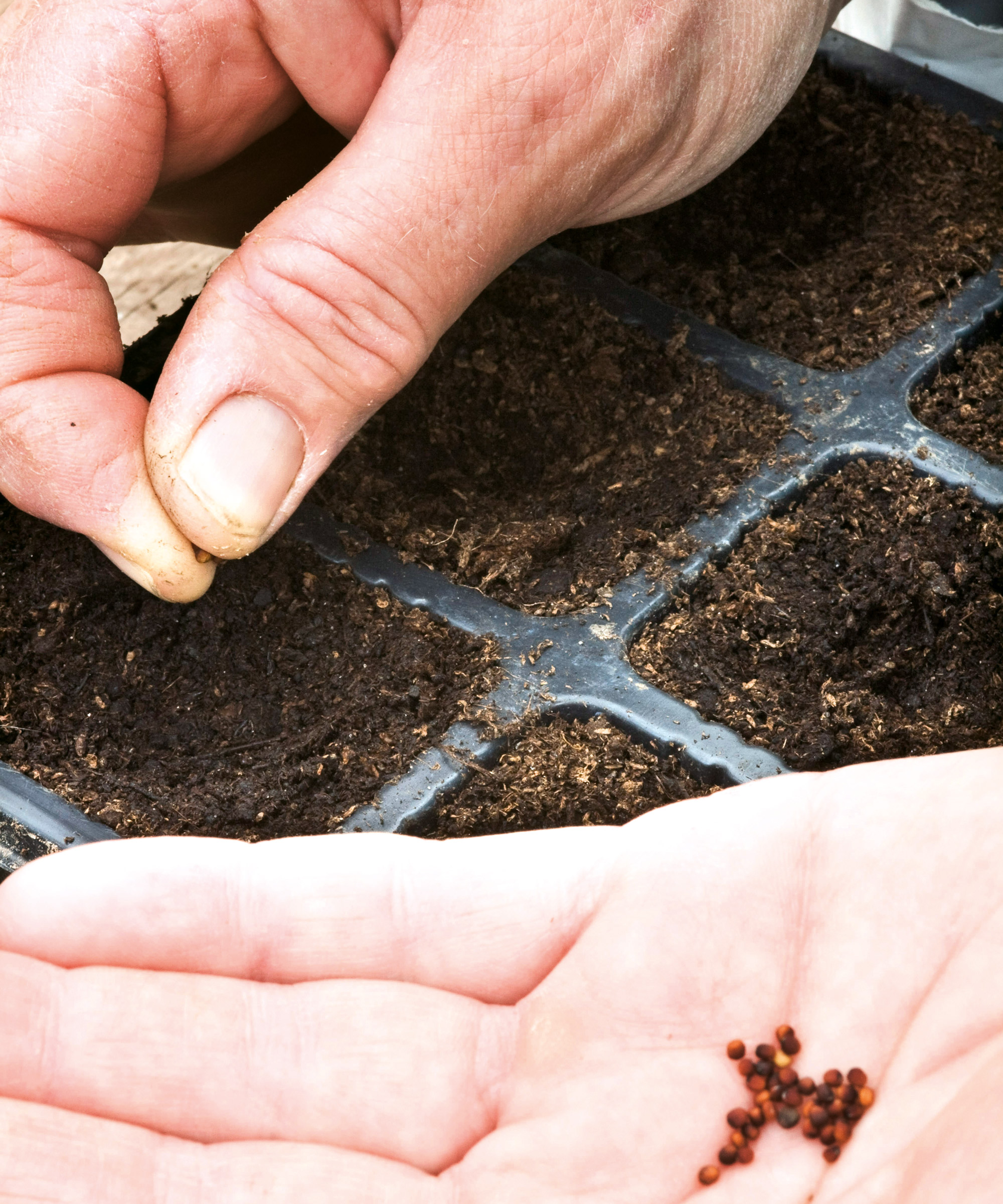
Sowing into modules undercover allows protection from slugs and flea beetles, both of which love brassica seedlings. Protected under cover in a greenhouse or similar, you also get better emergence. For more on what to grow in the greenhouse each month, see our guide. These seedlings can be transplanted out in June-July with no root disturbance.
Sow one or two seeds per module of well-watered seed compost. For purple sprouting and winter cauliflowers, multi-purpose potting compost is fine, and you can use 3in (8cm) pots instead. Sprinkle a thin layer of finely sieved compost over the top and place the pots or tray in shallow water until damp.
Popped in a propagator set at 15-18˚C (59-64˚F), winter brassicas will germinate in seven-10 days. Cauliflowers and purple sprouting both prefer higher temperatures of 21-27˚C (70-80˚F). Kale can germinate in a wide range of temperatures, from 5°C to 30°C (41-86°F).
Thin out to leave the strongest seedling. Remove from the propagator. Position somewhere light at a cooler temperature, until they are large enough to plant outside. This can be five-six weeks, depending on the variety.
How to sow winter brassica seeds outdoors
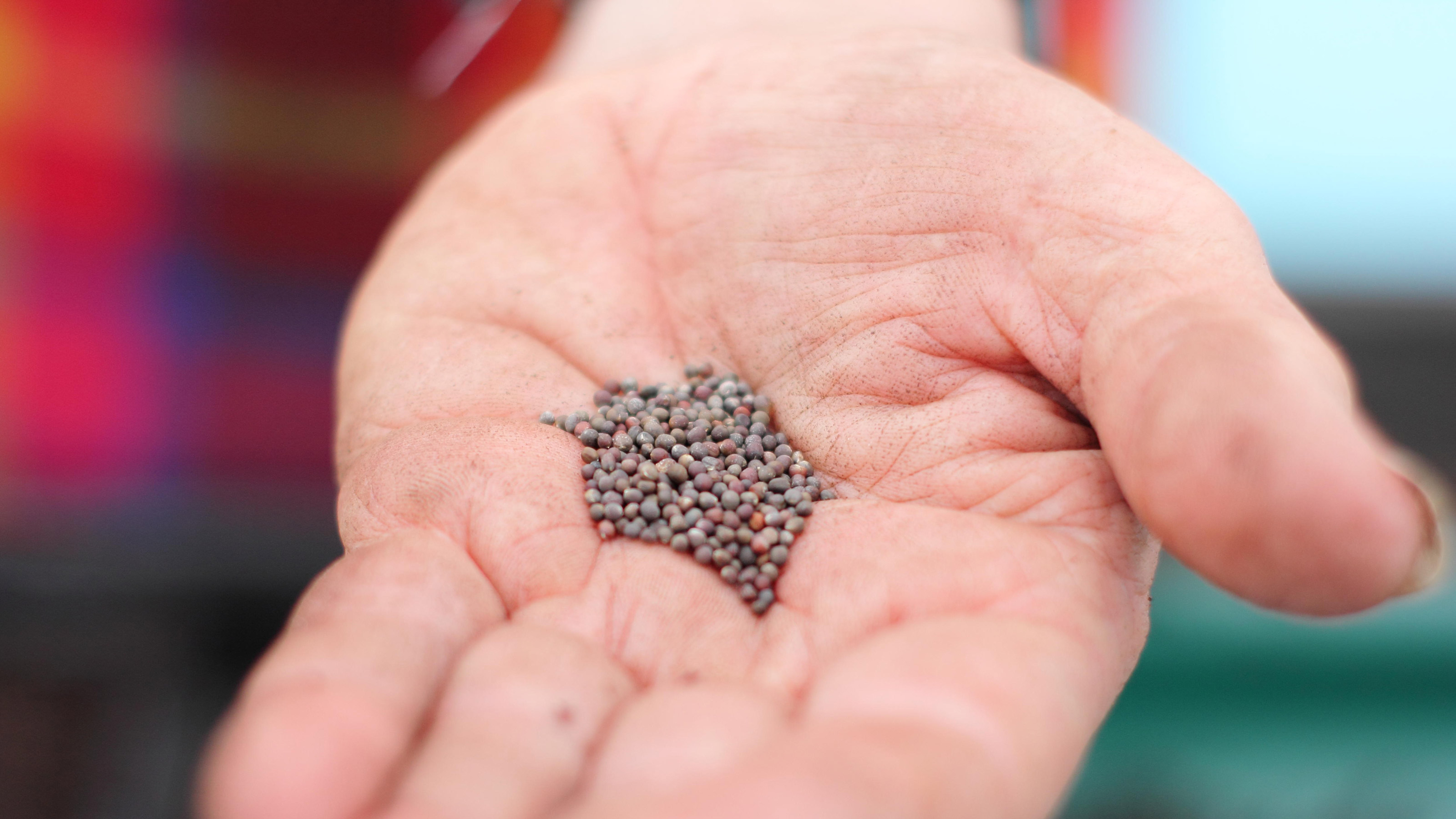
The traditional way to sow brassicas is in a seedbed outside, with seedlings later transplanted to final positions. This is good for big cabbage and cauliflower varieties. This method is fine if you have prepped the soil. Remember, while the plants thrive in cooler climes, winter brassicas need relative warmth to germinate successfully.
If you have space, you can direct-sow into final spacing. For cabbages, aim for spacing the seeds 12-18in (30-45cm), depending on the variety. Make drills half an inch (1cm) deep, then sow thinly. For cauliflowers, sow 2cm deep, spacing 6in (15cm) apart for miniature varieties and up to 24in (60cm) apart for larger types.
For purple sprouting, sow three seeds, 2cm deep, at one-foot (30cm) intervals along the row. When the seedlings are large enough to be handled, thin to the strongest every 30cm. Sow sprout seeds half an inch (1cm) deep, in rows 15cm (6in) apart. (Thin when seedlings are 3in/8cm tall.) For kale seed, it helps to make grooves in the soil, 1cm deep, then sow thinly in rows 6in (15cm) apart.
In all cases, once you have sown your winter brassica seeds, cover them lightly with soil and make sure they are watered in well.
It’s preferable to sow in final positions so as not to disturb roots, but it’s OK to sow elsewhere if space is tight, and transplant seedlings when they are big enough to handle safely. It comes down to the space you have available when sowing. You can find out more about how to transplant seedlings with our guide.
How to plant out winter brassicas
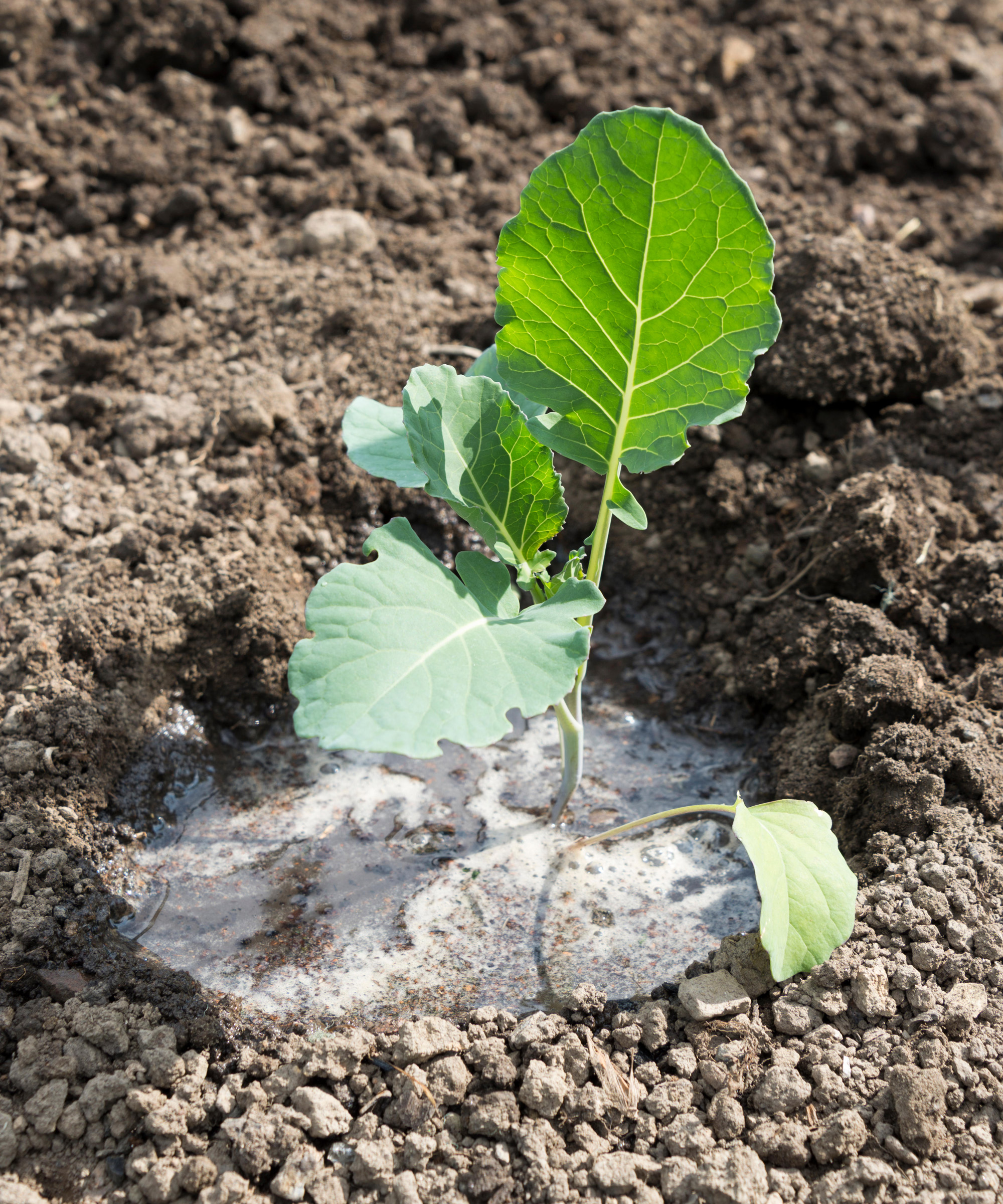
Knowing how to grow winter brassicas is a lot to do with timing - taking advantage of the gaps freed up as summer crops are lifted. As space returns on the plot, it’s easy to transplant seedlings started indoors or from a seedbed, or brought in as plugs. Ideally, the plants should be 3in (8cm) tall; this needs to be 5in/12cm for sprouting broccoli.
You can transplant around six weeks after sowing. Cabbage, cauliflower, kale and purple sprouting plants should have five or six true leaves before being transplanted to their final growing positions. Sprouts ideally need seven true leaves, and should be around 4-6in (10-15cm) tall before being planted out to their growing spots.
If planting out seedlings started in pots, tip each brassica from its pot and plant it firmly in the ground. Plant out according to the spacing suggestions that came with your seed packet or plug supplier. This can be 3ft (1m) apart for large cabbage, sprouting and cauliflower varieties. As a general rule, space plants 12-20in (30-50cm) apart (sprouts benefit from being spaced 2ft/60cm apart).
Firm the transplants in well, then water them thoroughly to help them settle. It might also help to sprinkle on a good general fertilizer like fish blood and bone, especially for purple sprouting varieties. For all winter brassicas, don't forget about watering plants well after planting.
Top tip: If conditions are dry when you are planting, ‘puddle in’ the plants by filling the planting holes with plenty of water. Fill this hole with water several times before adding soil so the plant has ample moisture.
Adding netting to winter brassica plants
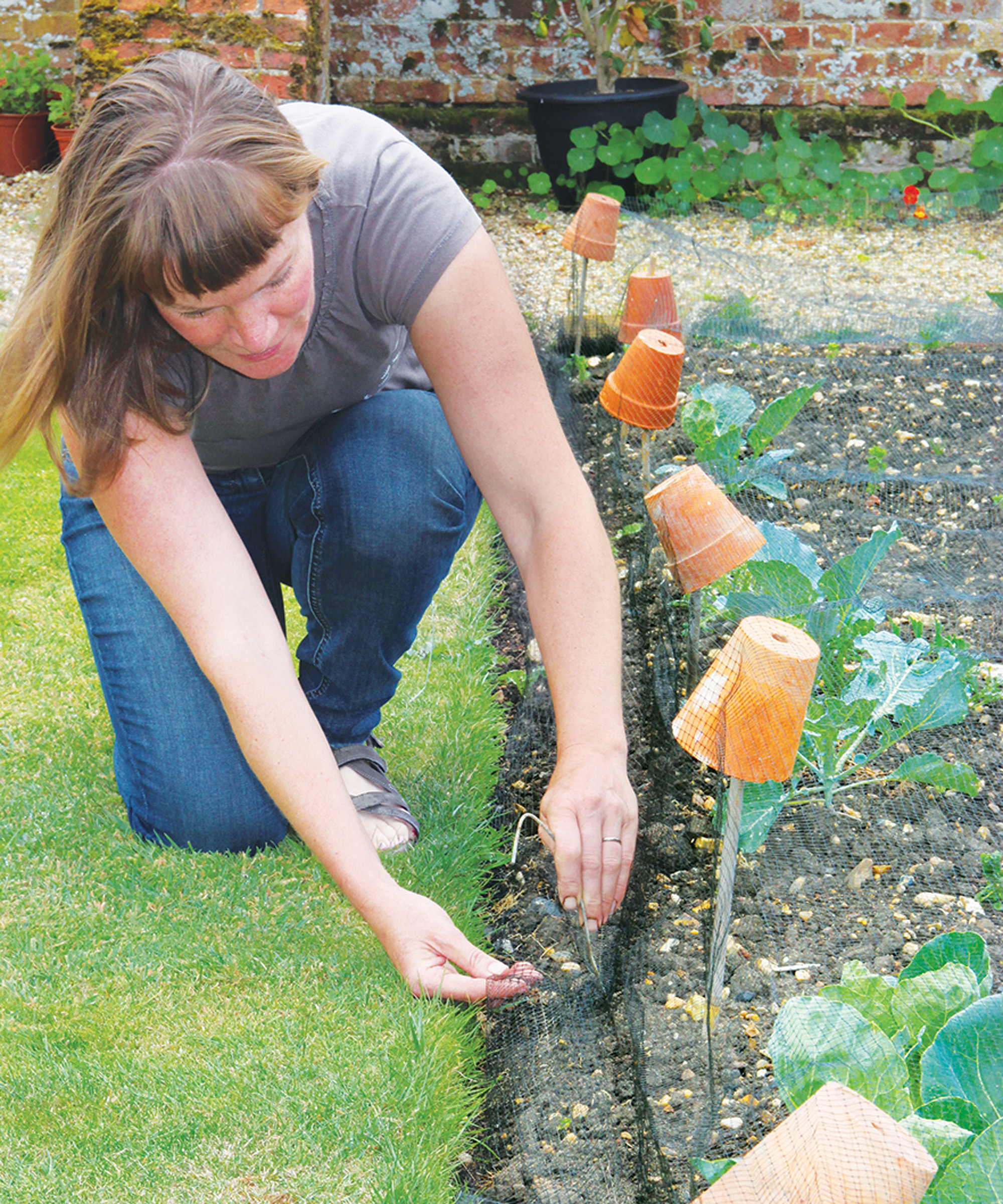
A key part to learning how to grow winter brassicas is making sure you protect your plants once they are in the ground. This means cloaking the plantings in fine-mesh netting (5mm or less) to protect against wood pigeons and to prevent cabbage whites from laying eggs. Take special care that the leaves don’t touch the netting. Support the netting with canes topped by inverted terracotta plant pots.
You can also get vegetable ‘cages’ with aluminium supports to hold the netting. To calculate how much netting you need for a cage, add around 4.5ft (1.4m) to the length and width of the planting site to allow for height. Secure to the ground with pegs every 1.5ft (half a metre).
Where to grow winter brassicas
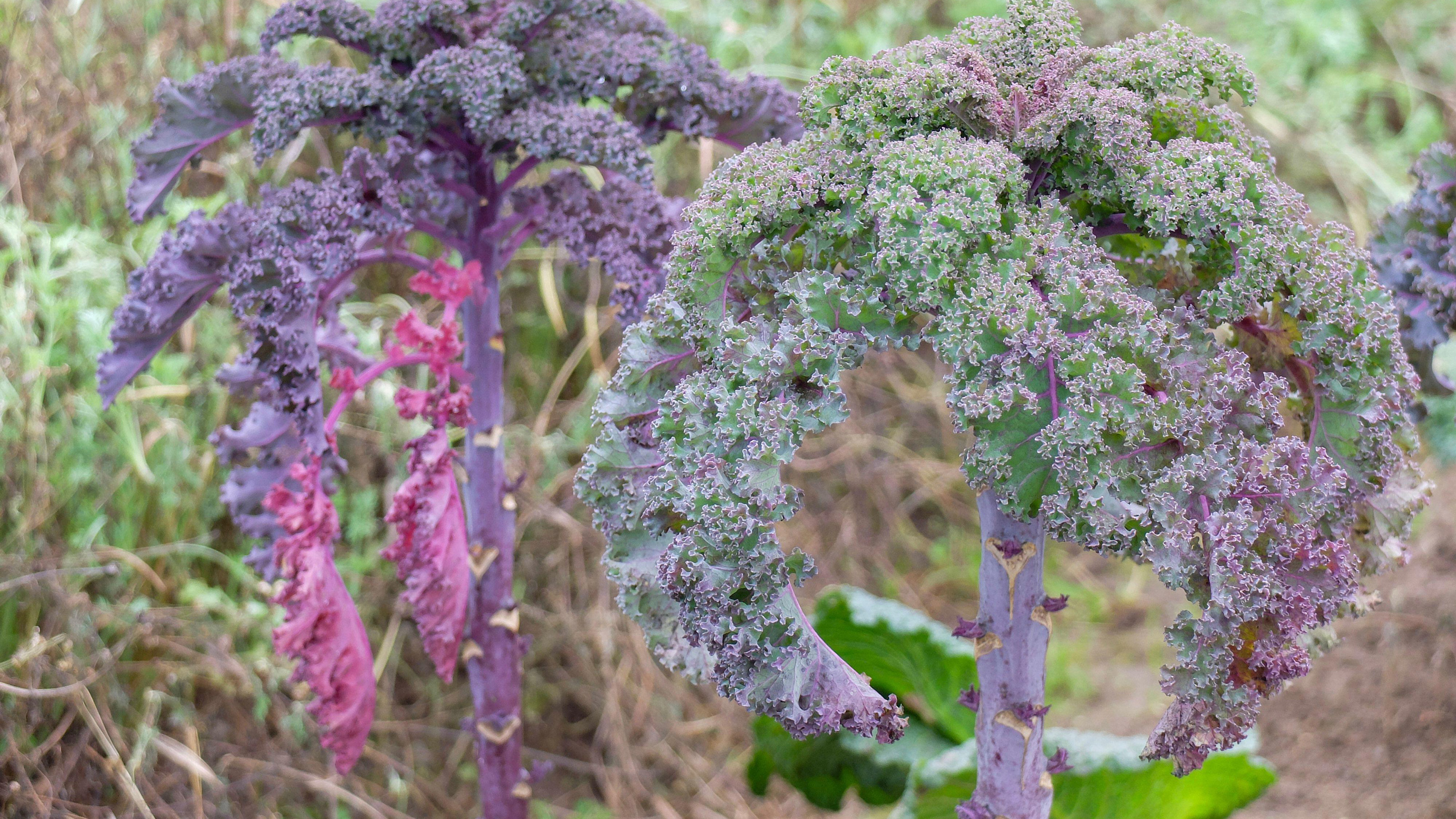
To make sure you have success as you learn how to grow winter brassicas, the prime consideration is space. Some kale, sprouting and Brussels sprouts varieties grow several feet tall, and the bigger cabbages and cauliflowers can grow to gargantuan proportions.
Brassicas are generally grown on light and sandy soils. Some breeds are drought-tolerant, particularly those with greyer leaves, but it’s wise to ensure you have an efficient irrigation system in place. Check you have easy access to water butts or similar to keep them well watered.
- Cabbages and cauliflowers do best in a sunny site with shade, and deep, fertile neutral-alkaline soil. Hopefully, you have followed our soil prep guide, but keep a close eye on ground conditions as the plants develop. Make sure the soil is firm and not loose.
- Sprouts also need a firm, fertile site – and shelter from strong winds (staking is recommended). They grow well in sun or shade. Brussels sprouts have less foliage, so give some thought to quick-growing crops you can grow around them. This process is called interplanting. Lettuce, swedes and radish make great companion plants (see our companion planting guide for more about beneficial plant combinations).
- Kale is tolerant of most conditions apart from water-logged soil and too much shade. Make sure the soil is moist but well-drained and firm, and that plants will be secure.
- Purple sprouting plants like full sun but produce better heads in cooler conditions – too much heat runs the risk of them going to seed prematurely. They are hardy, though, and can handle temperatures as low as -12°C (10.4°F). Again, the right shelter and/or staking will be key to success. They prefer a heavy but well-drained alkaline soil.
One final note on location: don’t plant on the same spot for two consecutive years. This rule applies even if you are growing a different member of the brassica family. Pick a different place to avoid running the risk of root disease. Brassicas thrive in spots formerly used by beans and peas, as those plants leave plenty of nitrogen behind in the ground.
Want to grow a winter veg that thrives on acid-based soil? See our guide on how to grow leeks to learn how to cultivate this winter warmer.
How to care for winter brassicas
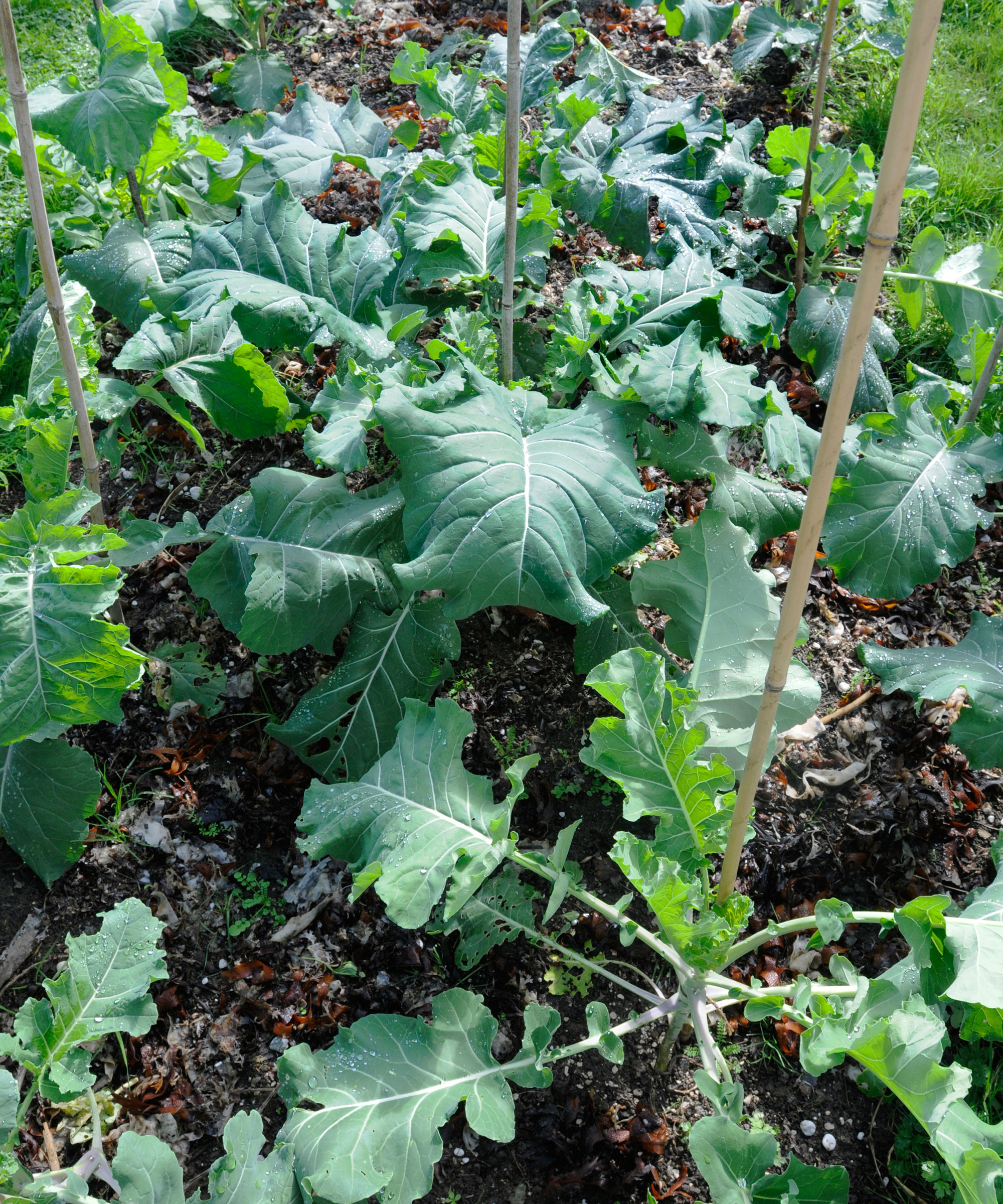
As you learn how to grow winter brassicas, you’ll see that once they are established, they are easy-going plants on the plot. However, crop yield is connected to foliage (with the exception of sprouts). Water generously every few days (more in dry spells). Make sure the root zone gets soaked.
As well as occasional liquid feeds, top up nitrogen levels with a nitrogen-rich feed such as Growmore in early September. You can do this once a month for sprouting. Monthly applications of fish blood and bone are beneficial for sprouts. Apply this every eight weeks for developing winter cabbage and sprouting.
Remove yellowing leaves from kale, sprouts and sprouting plants to prevent disease. It’s wise to weed sprouts and purple sprouting by hand, taking care not to disturb the roots. Cabbage beds will also benefit from manual weeding so plants don’t end up gasping for nourishment. There's advice on how to get rid of weeds in our guide.
Cauliflower curds need protection as they develop. Bend some of the upper leaves over them. Doing this in late autumn will protect against frost damage. When the heads are forming, a few weeks before harvest, stop feeding with a nitrogen-rich fertilizer and use a high-potash feed.
To reduce the risk of bolting in purple sprouting during hot summers, apply some mulch. Cabbages and cauliflowers will also benefit from a mulch at this time. In September, mound some soil around the bases of the stems of sprouts to provide extra support, before mulching with well-rotted compost. Find out more about mulching in our guide.
How to tackle winter brassica problems

When you learn how to grow winter brassicas, you will see how enticing they are to various garden pests. There are also a couple of major diseases that can debilitate brassicas. Try to think ahead of the problem:
- Club root This destructive fungal disease is a biggie for brassicas if the soil is acidic. Roots get swollen, and leaves pale and wilt. Buy a soil testing kit. If the pH is under pH6.5, lime the soil to pH7.5 to deter club root. Also strive to prevent waterlogging. Try resistant varieties like Sprout ‘Crispus’, Cauliflower ‘Clapton’ and Cabbage ‘Kilaton’.
- Cabbage whites Large and small cabbage white caterpillars can ruin the quality of a harvest and strip plants bare of foliage and leave big holes in leaves. Netting is the key way to alleviate huge amounts of misery. When you add netting over plants, take care the leaves don’t touch the nets. You’d be amazed how resourceful cabbage whites are.
- Root fly Cabbage root fly can attack all brassicas. Female flies lay eggs around the base of plants in late spring and summer. Key signs are stunted growth, wilting and larvae on the roots below the soil surface. This can be prevented by placing root fly collars around transplants.
- Slugs and snails It’s quite common to see the silvery trails on the leaves of young plants and also on the soil around them. To combat this, try barriers such as eggshells or copper tape. Alternatively, try ‘slug pubs’ (cups or dishes of beer) placed nearby. To find out more about how to get rid of slugs, check out our guide.
When to harvest winter brassicas
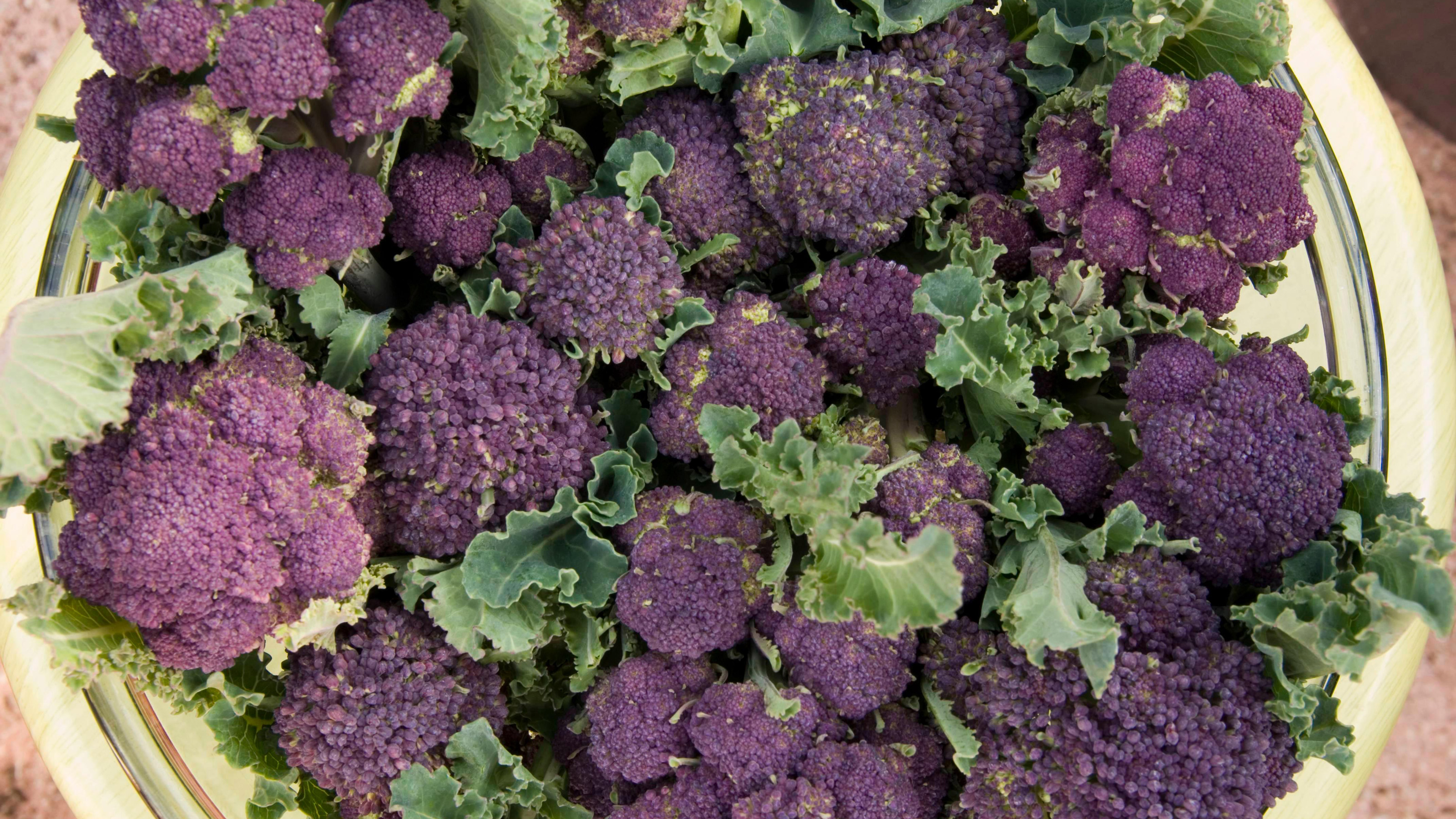
Once you have mastered the art of how to grow winter brassicas, you can look forward to an eclectic, eye-catching and nutritious feast. Here’s how to ensure you are gathering your bounty of brassicas at their absolute best:
- Winter cabbage These take four-six months to reach maturity, depending on the variety. To harvest, cut the stem just above ground level. If you cut a half-inch (1cm) cross in the stump after harvesting, you may be rewarded with a few (smaller) cabbages a few weeks later.
- Winter cauliflower These take three-five months from sowing to maturity, depending on the variety and the weather. Check the head is firm (5in/12cm wide will taste lovely) and cut the stem with a knife. Take the head and a few of the leaves underneath it.
- Purple sprouting Takes two-three months to crop. Cut the central spear first to encourage the smaller spears on the side-shoots. That way, you can pick over four-six weeks. When harvesting side-shoots, leave a part of the stem to sprout more spears. If you made several sowings, you can harvest until spring. Best eaten immediately.
- Brussels sprouts Can take 30 weeks to reach maturity. Pick the lowest sprouts first, when they are tightly closed (about 2cm wide). Remove with a downward tug. This will encourage the top sprouts to ripen. Sprouts of about 1.5in (4cm) are the best tasting.
- Kale Should be ready from November. Harvest the top leaves first, removing four leaves per plant. Pick the leaves when young, 4–6in (10-15cm) for the best taste. Side-shoots can be harvested from February. Curly kale tastes even better in cold weather.
Would you like to find out more about how to harvest other veg? Read our guide on when and how to harvest vegetables so you can be sure you eat them at their best.
Best winter brassica varieties to try
So now we have shown you how to grow winter brassicas, are you ready to get cracking? Enjoy some cool runnings with these luscious, leafy beauties:
1. Cauliflower Romanesco Veronica
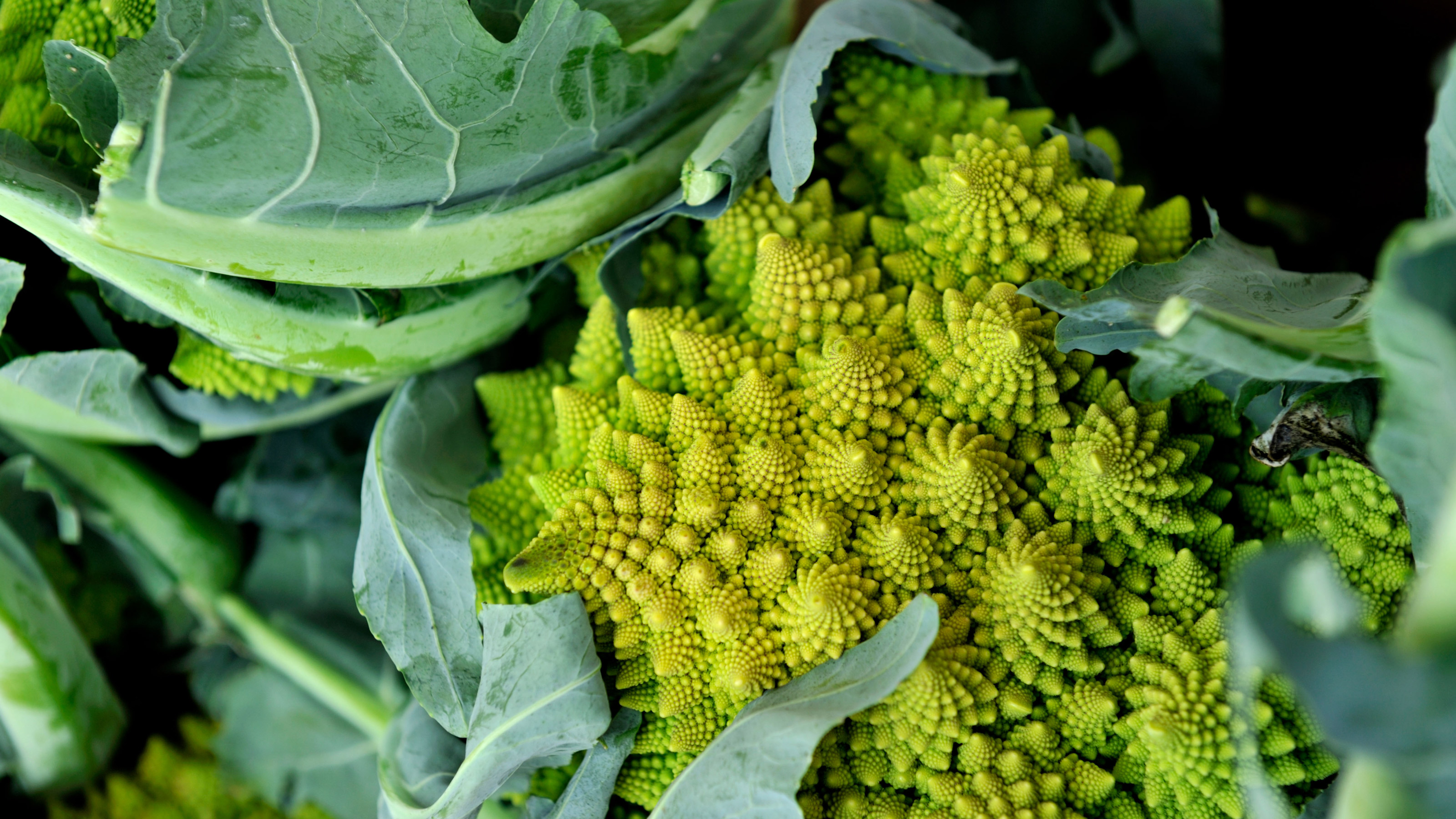
This chartreuse F1 hybrid is a fascinating entry point into Romanesco cauliflower growing. Referred to as a ‘brocco-flower’ (a cross between cauliflower and calabrese), it is milder and sweeter than its cauli cousins. Best of all, it keeps its color when cooked! Harvest until December.
2. Cauliflower Triomphant
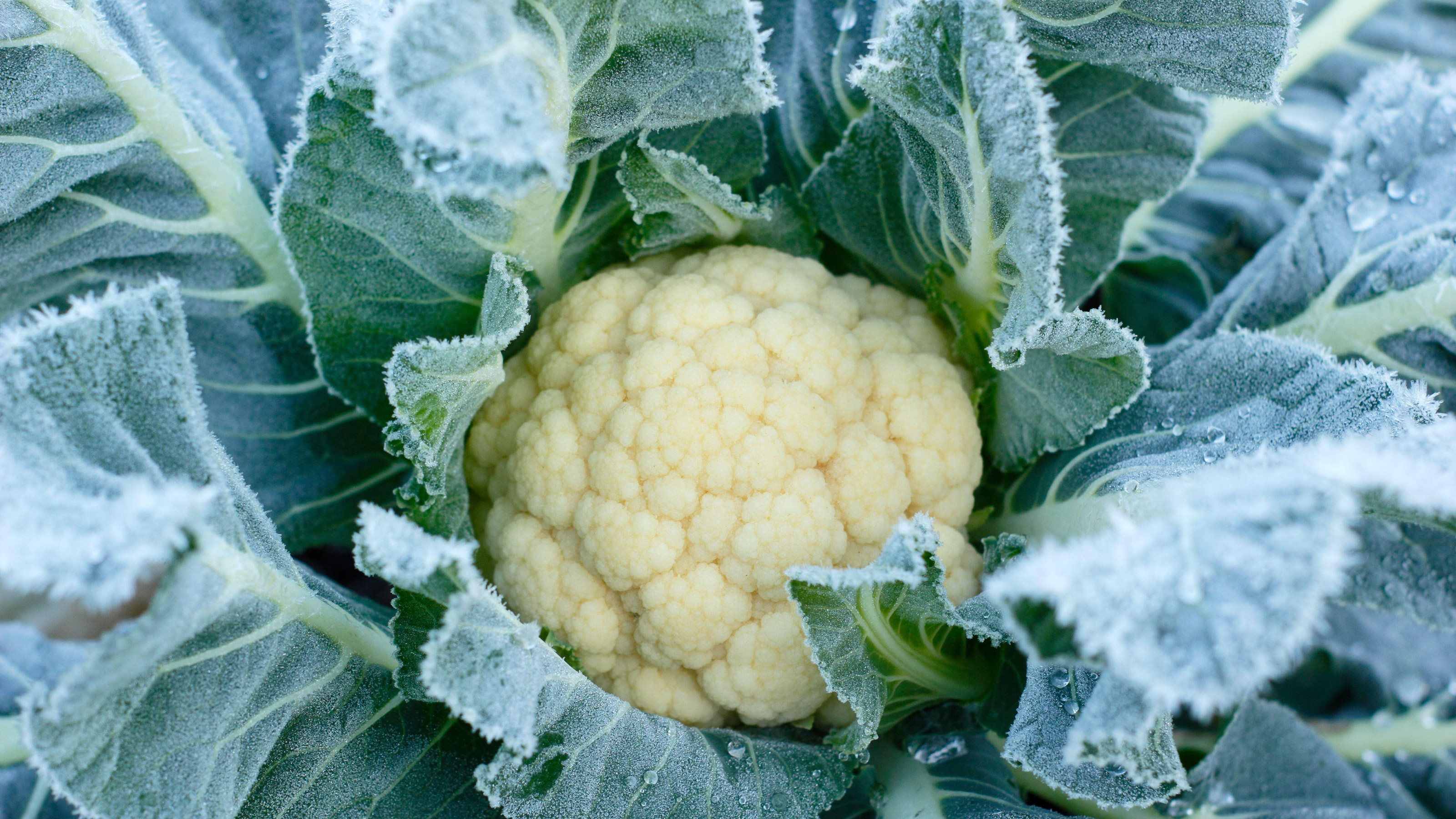
Delicious AGM winner and Roscoff x autumn hybrid that’s perfect for Christmas dinner, and much more. The dense white curds are kept protected by robust, semi-erect foliage. Resistant to freezing and disease. A mid-July planting gives crops to mid-January.
3. Savoy Cabbage Tundra
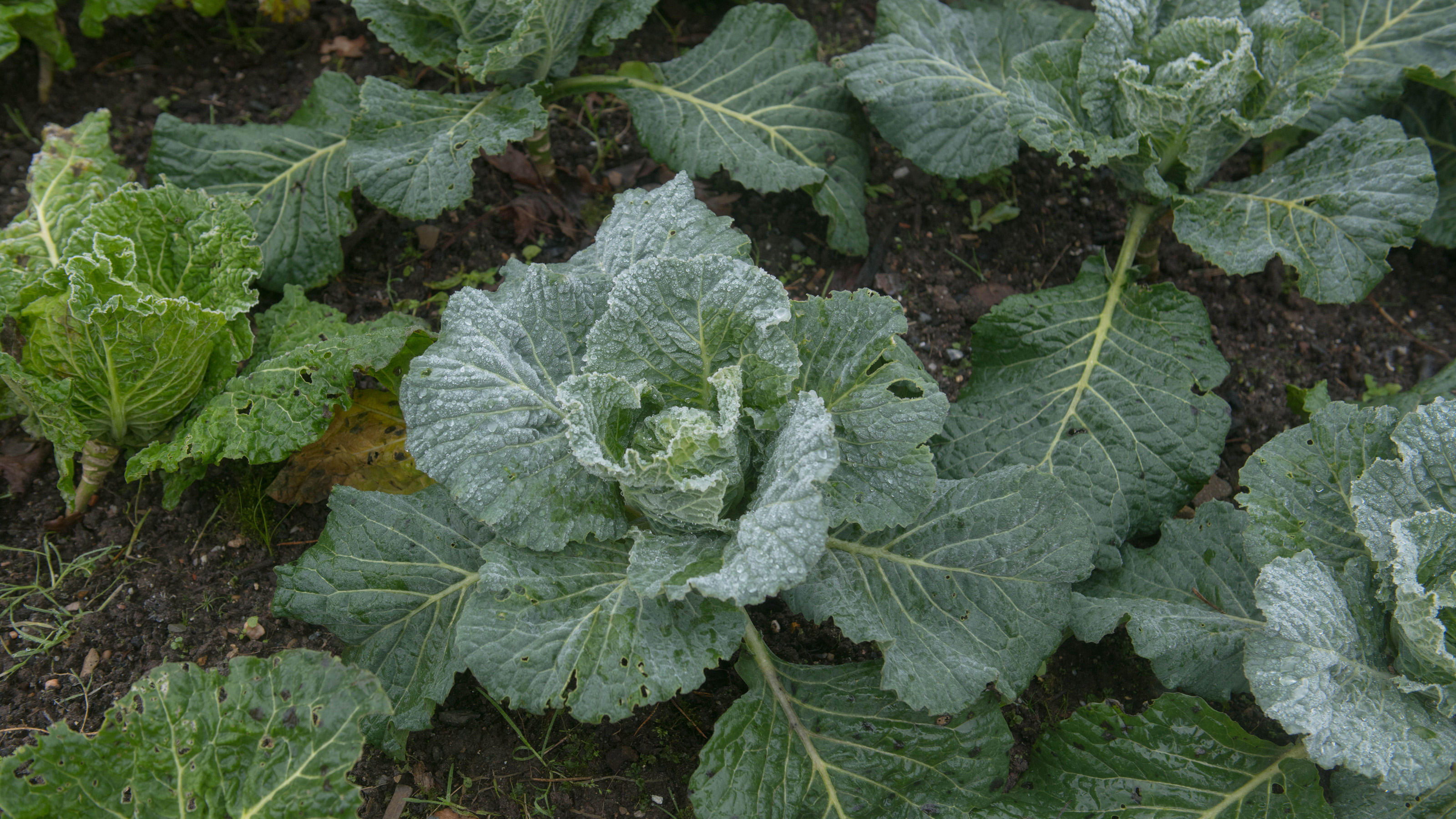
Sweet, nutty AGM winner that’s a Savoy ballhead cabbage cross. Real staying power through chilly winters and very high yielding. Combines all the hardiness of a Savoy and crispy flavour of a white ballhead. Said to harvest October to December, but has been known to last longer.
4. Winter Cabbage Marabel
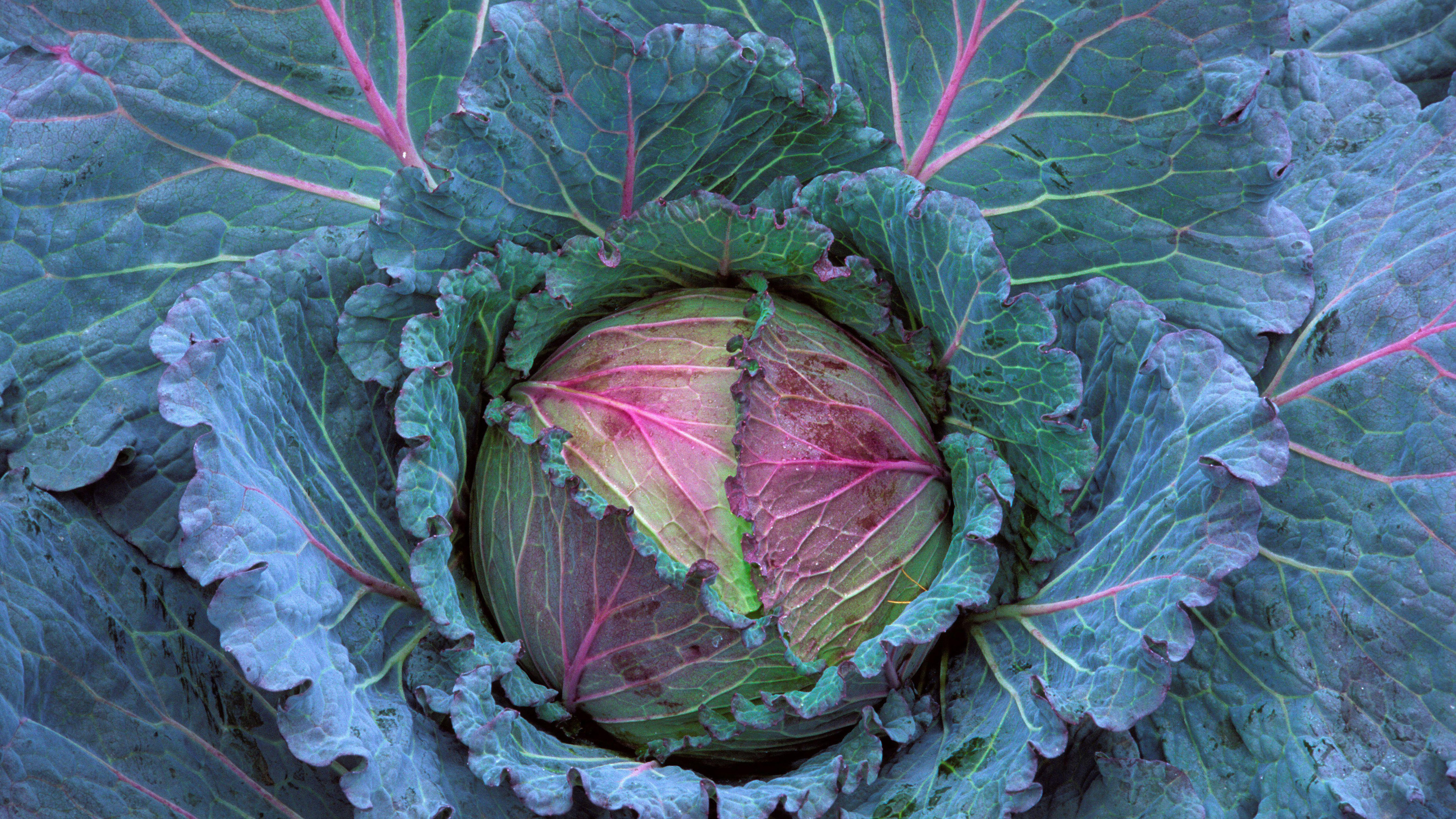
Lusciously tinted, red-purple blush AGM winner that looks as good as it tastes. It is said to improve on the much-loved 'January King' and is full of depth and rich flavor. Large, dense heads, and very high yielding. You can harvest this cabbage from November until March.
5. Kale Dwarf Green Curled

This frilly mass of leaves is a living work of art, but don’t let that stop you taking a bite or three. This curly kale is not just ornamental but a true survivor on a harsh winter plot. It copes well with windswept gardens and poor soils. A crinkle-leaved gem that’s packed full of antioxidants. Harvest January to April.
6. Brussels Sprout Falstaff
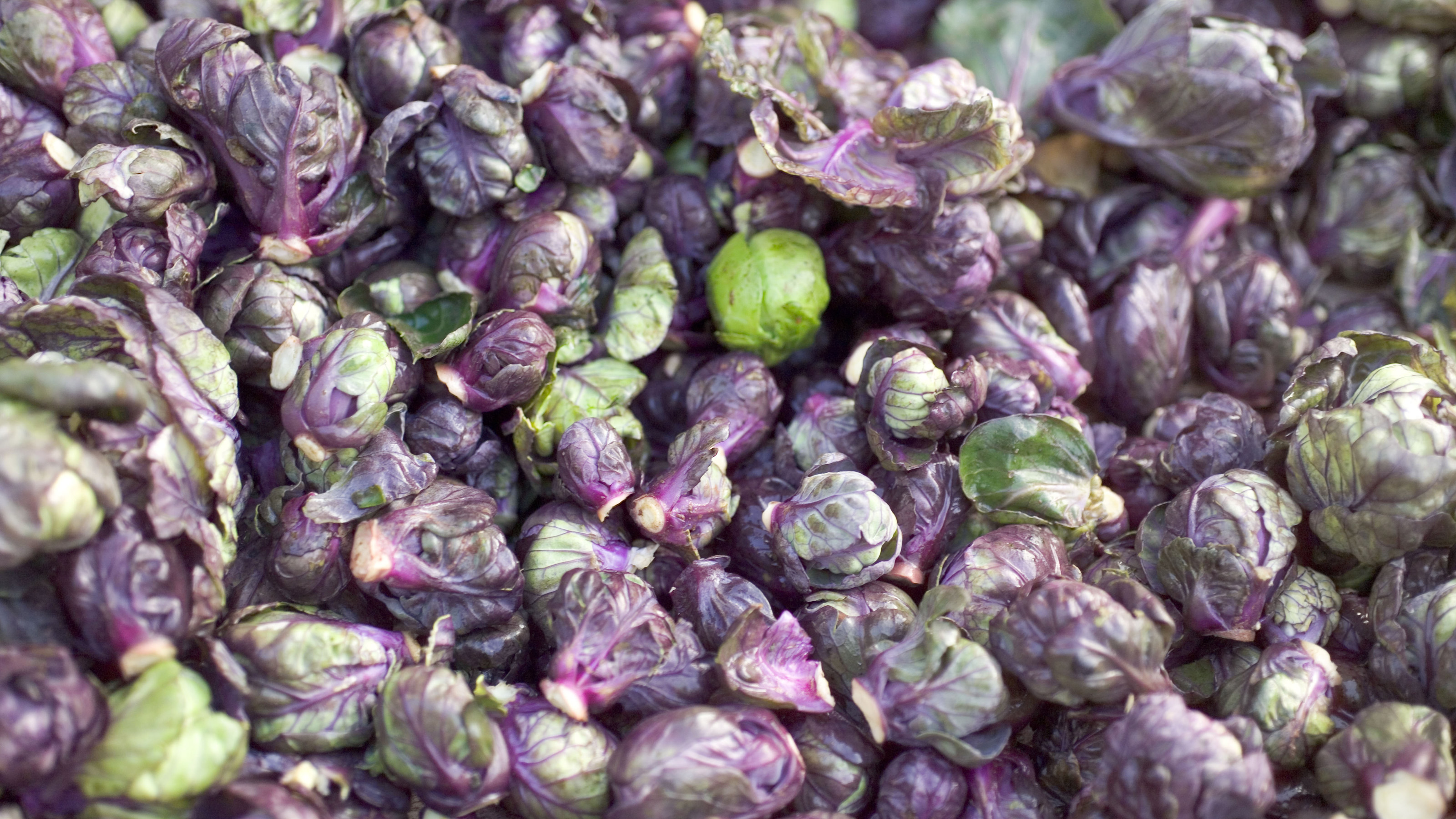
This pretty purple sprout develops over a long period, and has a softer flavour than its green comrades. The rich hues intensify to a beguiling blue-purple after a hard frost. They also keep their colour well when the sprouts are cooked. Harvest these tender, nutty buttons from October.
7. Purple Sprouting Early Rudolph
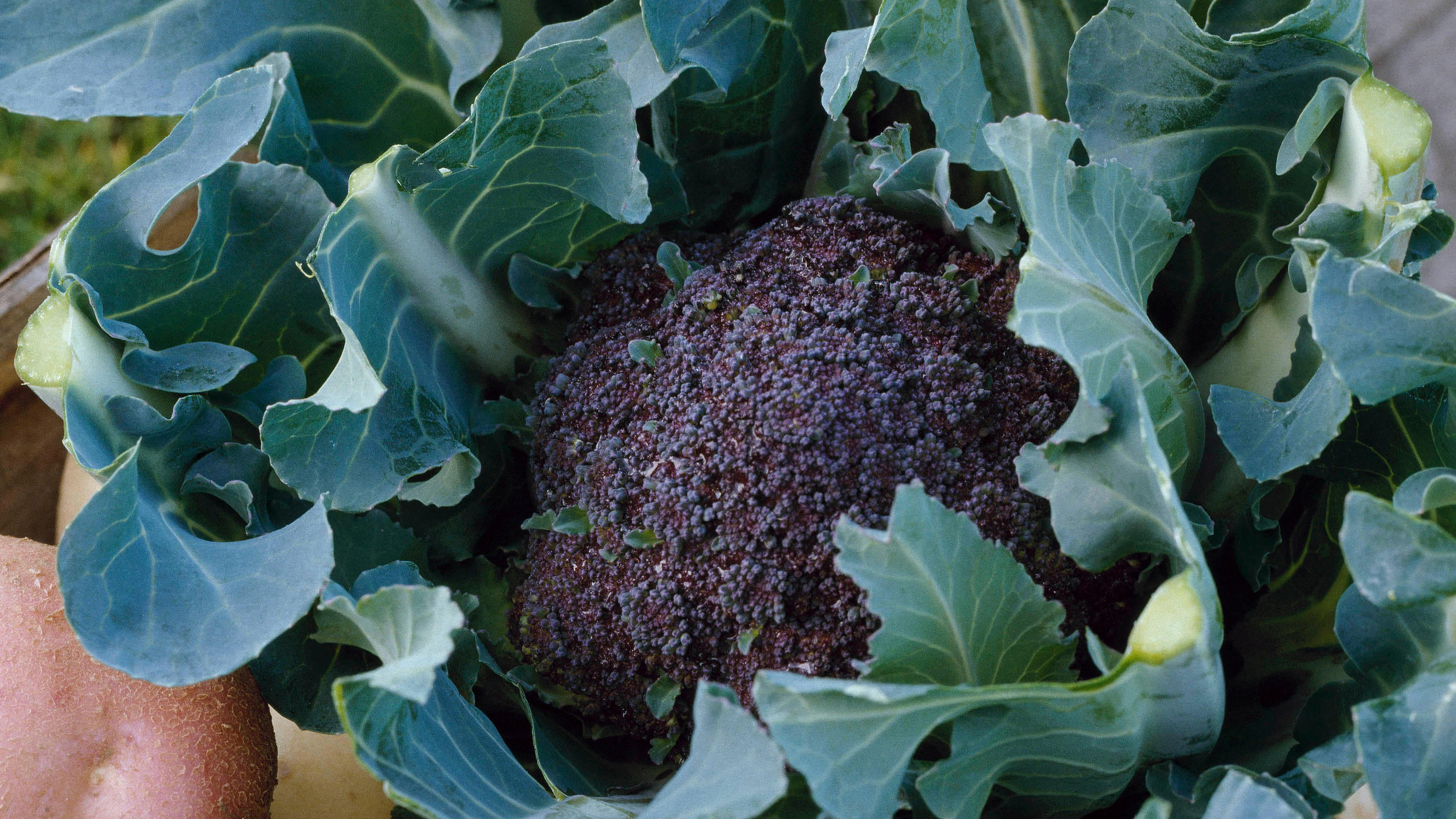
This purple sprouting broccoli is one of the earliest varieties around. It delivers rich, tender spears on large, sturdy plants. A vigorous plant that can reach 3ft (90cm) tall on richly nourished soils. Bred for Christmas, this one crops as early as October and can last until March.
Where to buy winter brassica seeds and plants
Winter brassica plugs and seeds are readily available from a wide range of suppliers. Use our quicklinks below to head straight to some leading seed suppliers, and try some of our recommendations on how to grow winter brassicas.
Where to buy winter brassica seeds in the UK
- Shop winter brassicas at Amazon
- Shop winter brassicas at Dobies
- Shop winter brassicas at Mr Fothergill's
- Shop winter brassicas at Suttons
- Shop winter brassicas at Thompson & Morgan
- Shop winter brassicas at Waitrose Garden
Where to buy winter brassica seeds in the US
- Shop winter brassicas at Amazon
- Shop winter brassicas at Burpee
- Shop winter brassicas at Home Depot
- Shop winter brassicas at Walmart
Does frost improve the taste of winter brassicas?
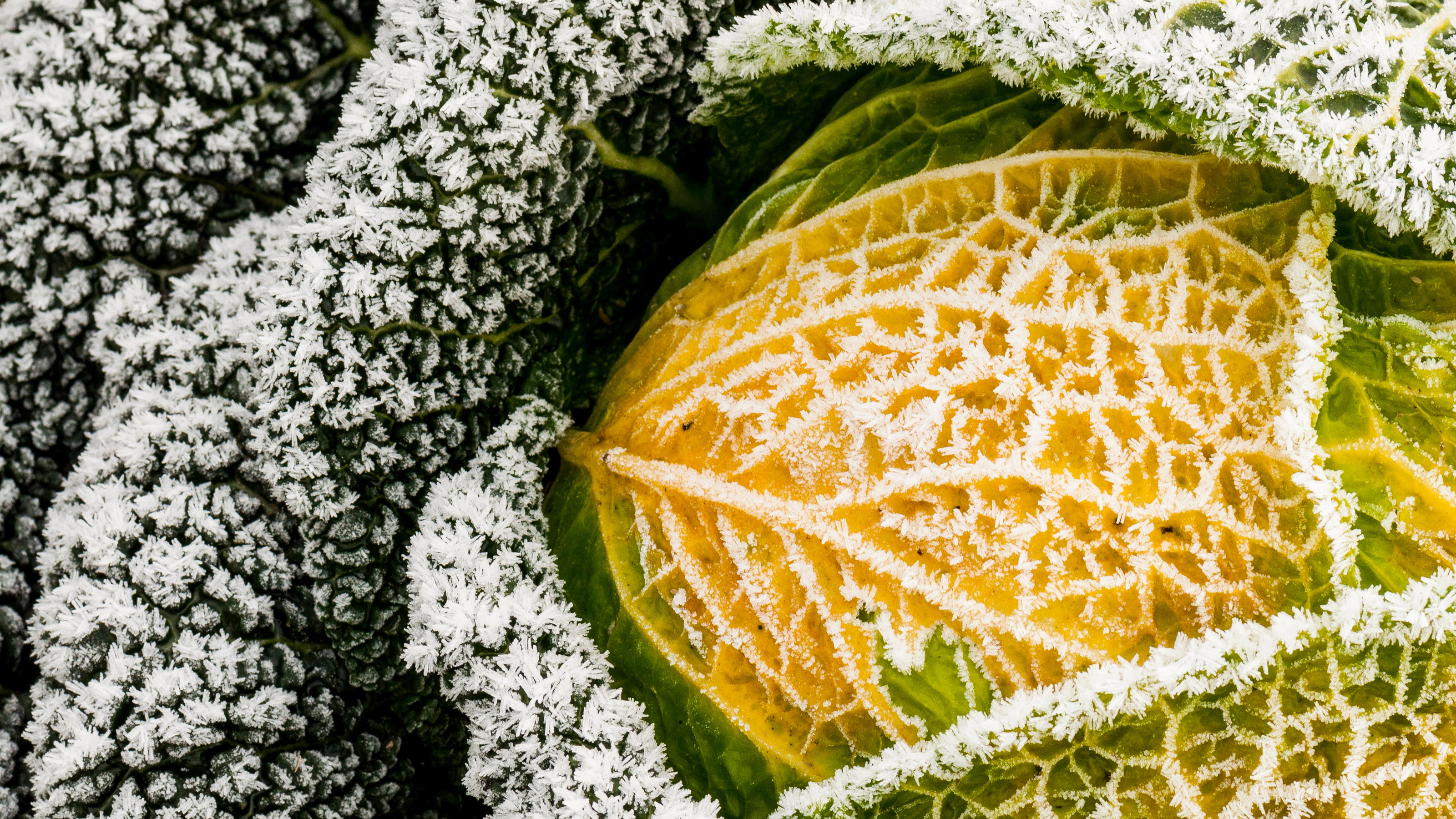
Yes, friends - it’s true! When it comes to learning how to grow winter brassicas, you’ll be pleased to learn that frost helps improve flavor. For summer cropping plants, frost is a sign of imminent doom and demise. But these beautiful veggies not only hold their own in cold snaps - they can actually taste better.
So depending on the variety, we encourage you to leave crops in the ground a bit longer (especially sprouts and curly kales). Certain sprout varieties (such as ‘Falstaff’) seem to develop in flavor after exposure to sub-zero temperatures. Similarly with kale, frosts improve the taste by turning starch to sugar.
We would ask you to exercise caution with winter cauliflowers, though. Quite often, the texture can be damaged, becoming loose and less compact. That said, frozen cauliflowers can still be lovely in soups. Want to know how to protect vulnerable plants from frost? Our guide on how to protect plants from winter will help here.
So now you know everything you need to get cracking with these cool crops. Make this your year for growing the best winter brassicas ever.

As assistant editor of Amateur Gardening magazine, Janey's gardening passion was fostered from an early age, when her amazing mum had her deadheading hydrangeas, mulching roses, and propagating strawberry plants from runners for school open days. She's also taken part in lots of conservation and rewilding projects for the RHS and TCV as a way of exploring her horticultural horizons.
